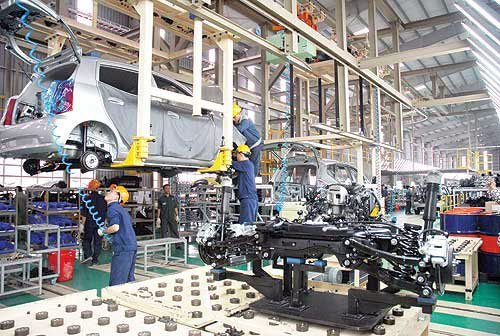VietNamNet Bridge – While the Ministry of Industry and Trade (MOIT) has been
making every effort to build up a strategy to increase the automobile output and
develop the automobile industry, the Ministry of Transport (MOT) and Ministry of
Finance (MOF) have been drafting the strategy to reduce the number of cars in
circulation to ease the pressure on the infrastructure system.
 |
|
|
Ngo Van Tru, Deputy Director of the Heavy Industry Department under MOIT, said that in order to encourage the development of the automobile industry, Vietnam needs to offer investment incentives to attract investors and encourage them to transfer technologies.
He said Vietnam has a high population and developing economy with improved living standards and higher car demand. However, the automobile market has been suffocated by the fee and tax policies. Nine types of taxes and fees have been imposed on car owners, which has led to the market getting narrower. With a small market, the automobile industry would not be able to develop.
The report released by MOIT showed that only 6982 cars were sold in April 2012, a sharp fall of 24 percent in comparison with March 2012 and 46 percent in comparison with the same period of the last year.
The ministry, while forecasting that with the overly taxes and fees, only 81,000 cars would be consumed in 2012, said that the Vietnamese automobile market is “going back to the past” with the output and sales equal to that in 2007. Meanwhile, the members of the Vietnam Automobile Manufacturers’ Association VAMA once hoped when they entered Vietnam that the sales would reach 140,000 cars by 2012.
Which policy for auto industry?
The automobile industry development strategy has been drafted by MOIT for a long time. However, to date, it still has not been submitted to the government because the ministry has not got the opinions from relevant ministries and branches on the draft strategy.
According to Tru, the draft strategy has been compiled, amended and examined thoroughly for many times. It was opened for discussion at many workshops. However, it still needs the opinion of the Ministry of Natural Resources and the Environment about the environmental impacts before it can be submitted to the Prime Minister.
The draft strategy was initially scheduled to be put on the Prime Minister’s table by the first quarter of 2012. However, it is now still unclear when the drafting would be completed.
Different ministries insist on different ideas
Tru emphasized that the contradictory policies are the main reason behind the underdevelopment.
“While MOIT has been making every effort to build up a strategy to increase the automobile output and develop the automobile industry, MOT and Ministry of Finance (MOF) have been drafting the strategy to reduce the number of cars in circulation to ease the pressure on the infrastructure system,” Tru said.
Do Huu Hao, Chair of the Vietnam Automobile Engineering Association, former Deputy of Industry, also said that the biggest problem now lies in the policies. He believes that it’s necessary to lay down a transparent policy for the post-2018 period, when the imports from ASEAN would not bear taxes any more.
“If Vietnam does not make a breakthrough in its policies, its automobile industry will never be able to develop,” Hao said, adding that it’s unreasonable for Vietnam to insist on the requirements on the high locally made content ratios.
Pham Dinh Thi, Deputy Head of the Tax Policy Department of MOF, has noted that the tax policies, in many cases, generate the conflicts among the groups of interests.
“Consumers want high quality, but cheap products. Importers want low import tariffs to boost sales, while domestic manufacturers always want higher import tariffs to boost sales,” Thi said.
Therefore, he said, the development strategies of different industries need to be designed in the way to harmonize the benefits of involved parties.
Tran Thuy